Walking through your front door straight into the living room? You’re not alone. Many homes skip the traditional foyer, leaving homeowners wondering how to create that welcoming first impression.
Here’s the good news: This layout doesn’t have to feel awkward or uninviting.
In this guide, you’ll find seven practical design ideas that transform your front door living room combo into a stylish and functional space. We’ll show you exactly how to create natural separation without walls, choose the right furniture placement, add storage that works, and make your space feel bigger and more welcoming.
Why trust these tips? They come from real interior designers who’ve solved this exact problem hundreds of times. Plus, we’ll share specific measurements and examples from actual homes.
Describing how the design ideas apply to different home sizes and layouts.. No expensive renovations required – just smart design choices that make a real difference.
Ready to make your entrance work for you?
Front Door Entryway Living Room Combo Ideas
Here are 7 ideas that you’re sure to love. Let’s get started:
1. Strategic Furniture Placement for Zone Creation
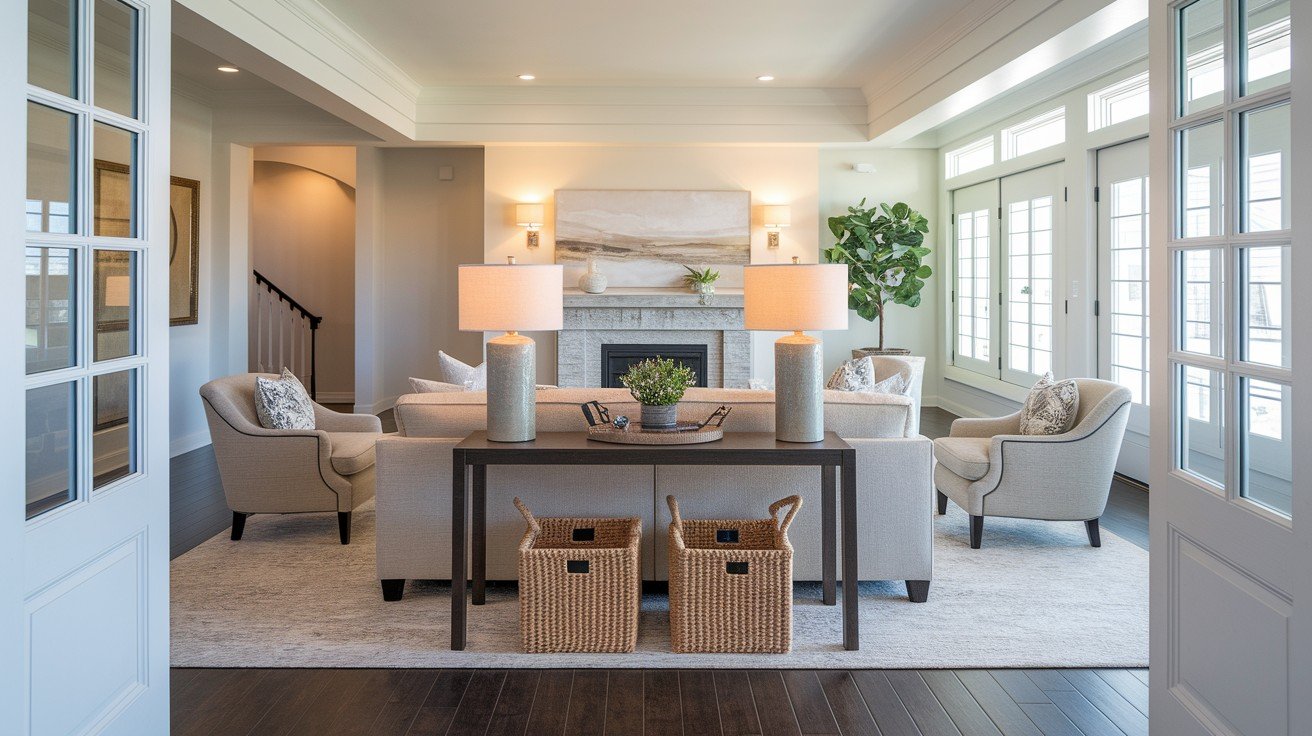
Here’s a simple truth: You don’t need walls to create separate spaces. Smart furniture placement does the job just as well. When your front door opens straight into your living room, furniture becomes your best friend.
The sofa barrier method might sound backward, but it works. Place your sofa with its back facing the front door. Your sofa becomes a natural divider that creates an instant entryway without blocking the view. For a 30 ft x 12 ft room with a 10 ft x 3 ft sectional, position it about 6 feet from the door. People naturally walk around the sofa to reach the conversation area.
Add a slim console table behind your sofa for extra separation. A 4 ft x 1 ft table creates visual barriers without eating floor space. Put a lamp, key tray, and maybe a plant on top. Use baskets underneath for mail and seasonal items. Keep it around 30-32 inches high to maintain open sightlines.
Smart seating does double duty. Angle accent chairs to face both the entryway and the main seating area. Guests can sit to remove their shoes, and then the chairs become part of your conversation group. Two angled chairs work better than one – they create a mini greeting zone that flows into your living room. The result? Your front door area feels intentional and welcoming.
2. Area Rugs as Visual Space Dividers
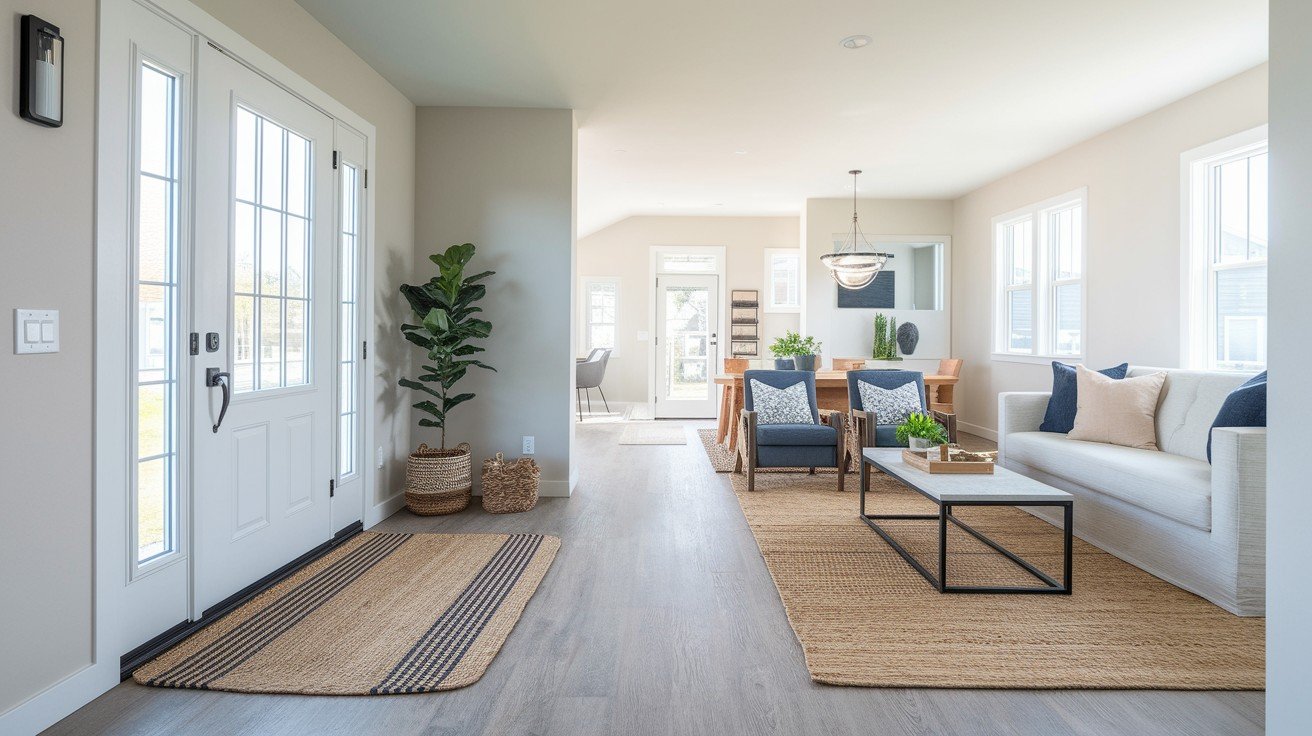
Think of rugs as invisible walls. They’re one of the easiest ways to separate your front door area from your living room without any construction. Here’s the simple strategy: Use two different rugs to create two distinct zones. One smaller rug near your front door signals, “This is the entry.” A larger rug in your living area says, This is where we relax.”
Size matters more than you think. Your living room rug should be big enough that all your furniture sits on it, or at least the front legs of your sofa and chairs. This creates a cohesive seating area that feels separate from your entry. For the entry rug, think practical. A 3×5 or 4×6 rug usually works perfectly near most front doors.
Color coordination keeps everything looking intentional. Pick rugs that share at least one color, even if the patterns are different. Maybe your entry rug has navy and white stripes while your living room rug is solid navy. They’re different enough to create zones but similar enough to feel planned.
Now let’s talk about materials, because not all rugs are created equal. Your entry rug takes a beating from shoes, rain, and daily traffic. You need something tough. Look for materials like polypropylene, jute, or outdoor rugs that can handle moisture and dirt. These clean easily and won’t fall apart after a few months. Your living room rug can be softer. Wool, cotton, or synthetic blends work great here since they don’t face the same harsh conditions.
3. Smart Lighting and Storage Solutions

Good lighting changes everything. When your front door opens into your living room, you need lighting that works for both spaces. The right lights make your entry feel welcoming while keeping your living room cozy.
A statement chandelier positioned between your entry and living areas does double duty. It lights up both spaces while creating a focal point that draws the eye upward. Layer your lighting for best results. Start with overhead lighting for general brightness. Add table lamps in your seating area for cozy evening light. Wall sconces near your front door provide welcoming light for guests. Don’t forget sheer curtains – they let in natural daylight while giving you privacy.
Storage should look like it belongs in your living room, not a mudroom. Look for cabinets that match your living room furniture. A storage cabinet that looks like a console table gives you hidden space for shoes and seasonal items. Guests will never know it’s actually storage.
Ottoman storage is genius for front door areas. People can sit on it to put on shoes, and you can store throw blankets or scarves inside. Wall-mounted hooks save floor space – choose wooden ones for farmhouse style, metal for modern looks. Keep them at different heights so everyone can reach them.
Create a daily drop zone that works. A small tray on your console table holds keys and phones. A basket underneath catches mail and dog leashes. Everything has a home, so nothing ends up scattered around your living room.
4. Color Schemes for Visual Continuity
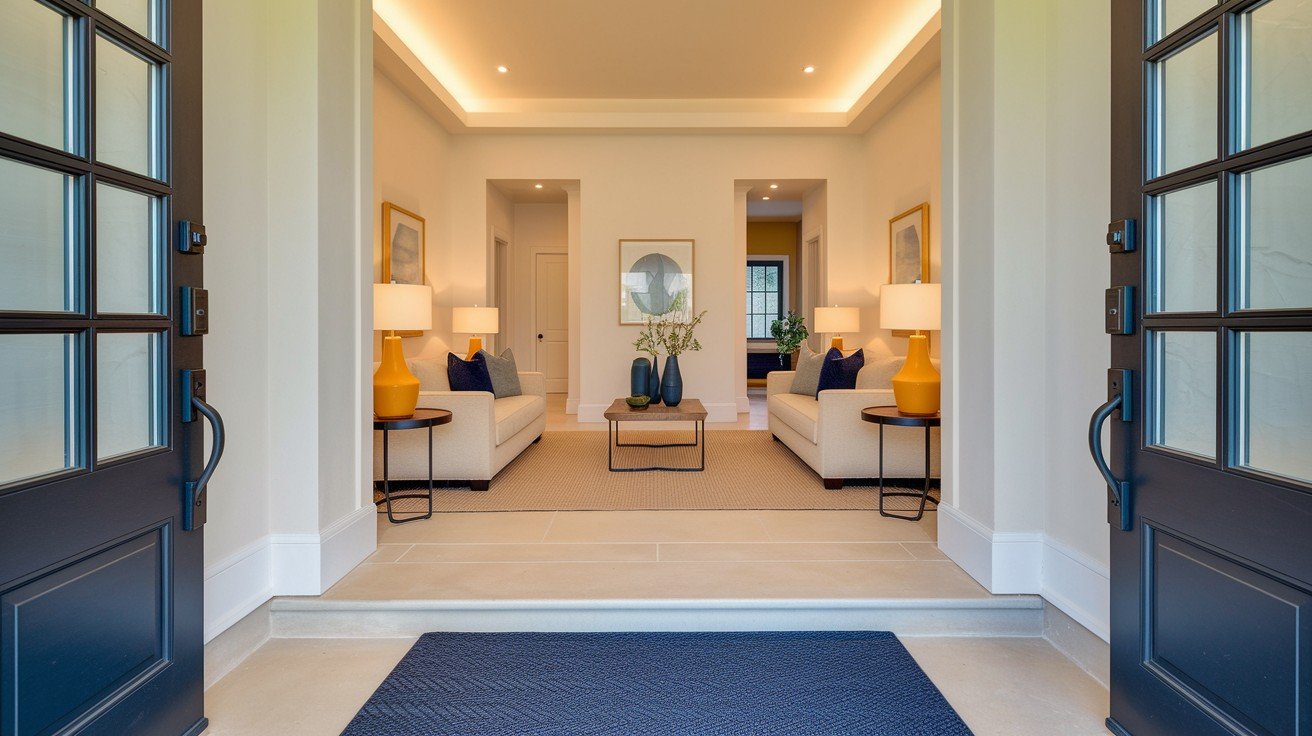
Color is your secret weapon for making one room feel like two spaces. When you use the right colors, your front door area and living room feel connected but still separate. It’s like magic, but way easier.
Start with neutral base colors – they’re your best friend here. Creamy white, soft gray, and warm beige work in almost every home. These colors make small spaces look bigger because they reflect light instead of absorbing it. Paint your walls in one of these shades, and your room instantly feels more open and airy. Think of neutrals as the foundation – everything else builds on top of them.
Now comes the fun part – adding accent colors. Navy blue and mustard yellow make a great combination that works in both traditional and modern homes. You don’t need to paint the entire wall these colors. Instead, bring them in through pillows, throw blankets, artwork, and small accessories.
Here’s how to do it right: Pick two or three accent colors and use them in both your entry and living areas. Maybe navy blue pillows on your sofa and a navy blue doormat at your entrance. Add mustard yellow through a table lamp and some small decorative objects. This creates visual flow between the spaces.
Balance is everything when you’re using bold colors. For every bold statement piece, add two or three neutral items. Remember the 60-30-10 rule: 60% neutral colors, 30% secondary colors, and 10% bold accent colors. This formula works every time and keeps your front door living room combo looking intentional instead of chaotic.
5. Room Dividers and Architectural Elements
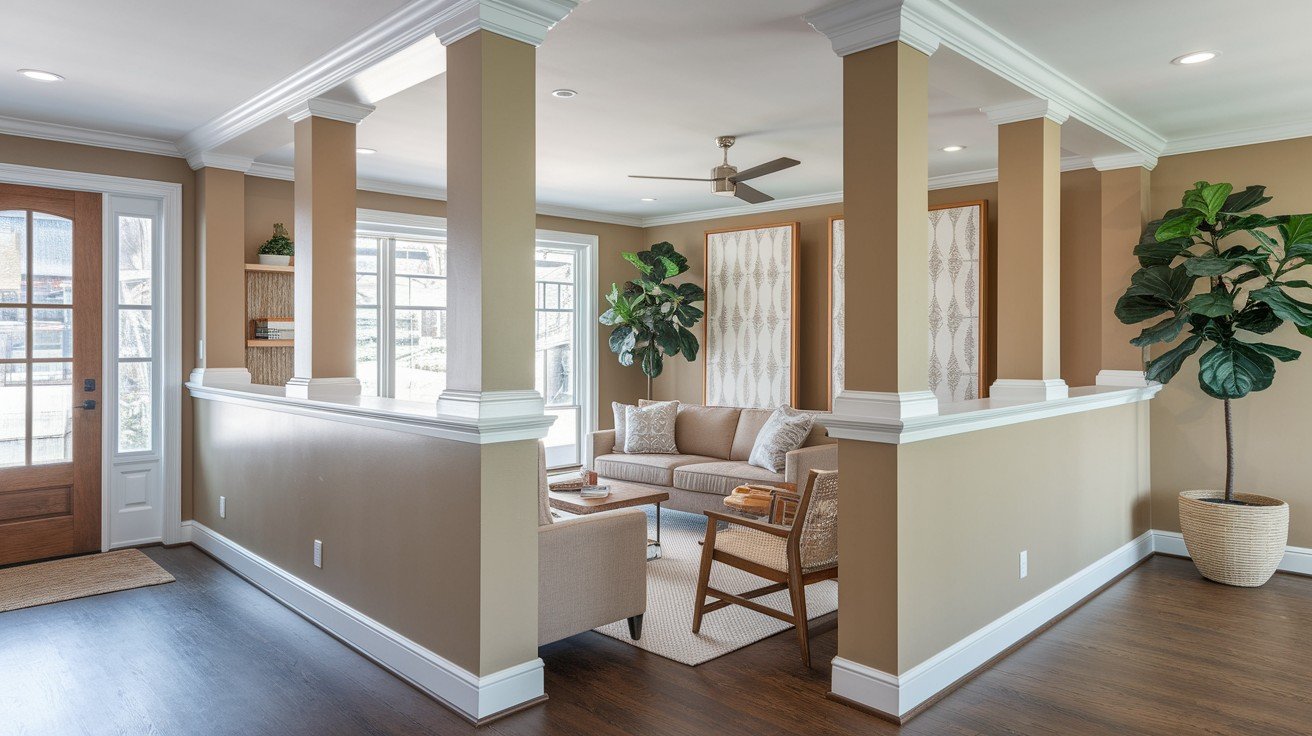
Sometimes you need more than furniture to create separation. If you’re ready for a bigger change, room dividers and architectural elements can give you that defined entryway you’ve been wanting. The best part? You still keep the open feel.
A half-wall (also called a pony wall) is one of the most popular solutions. Build it about 36 inches high – this gives you separation without blocking light or making the space feel closed off. It’s tall enough to create a visual barrier but low enough that you can still see over it. Add columns to your half-wall for extra style and structure. Choose square columns for a clean, modern look or slightly tapered ones for traditional homes.
Material choices change the whole feel of your space. Drywall painted to match your walls creates a seamless look. Wood adds warmth and works great in farmhouse homes. Stone or brick makes a bold statement but works best in larger spaces.
If building isn’t in your budget, try creative partition ideas instead. A bookcase room divider gives you storage and separation at the same time. Choose one that’s about 5-6 feet tall so it creates a barrier without touching the ceiling. Screen panels offer flexible separation you can move around. Folding screens work great because you can adjust them based on your needs.
Plants make beautiful natural barriers that don’t feel harsh. Use tall plants like fiddle leaf figs or rubber trees to create a green wall between your entry and living areas. Group several plants of different heights for a more natural, layered look. The bonus? Plants clean your air while they separate your spaces.
6. Mirror Placement and Decorative Accents
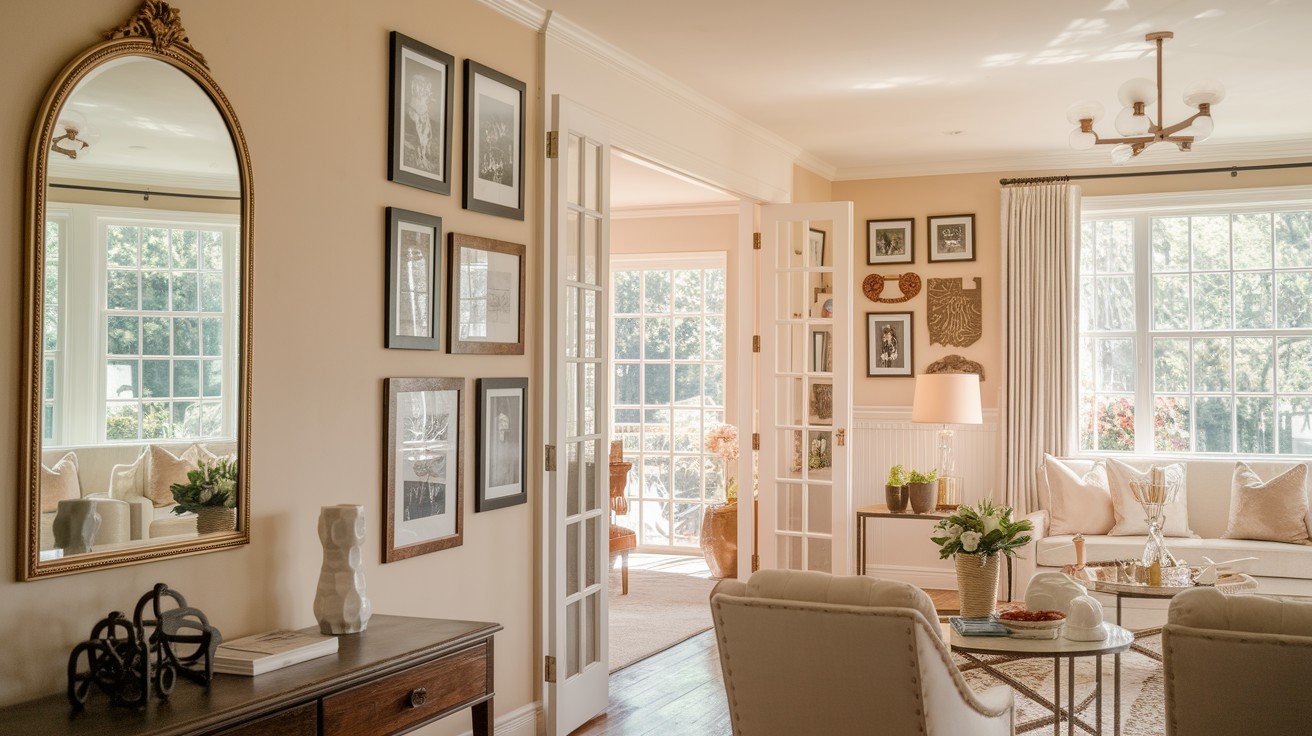
Mirrors are like magic for small spaces. They bounce light around and make rooms feel twice as big. Plus, they’re perfect for that last-minute check before you leave the house. When your front door opens into your living room, mirrors become even more important.
Place your mirror opposite a window if you can. This simple trick doubles your natural light and makes your space feel bright and airy. The bigger the mirror, the bigger the impact. A large mirror (at least 24×36 inches) creates the illusion that your room extends beyond its actual walls. Put mirrors on the wall next to your front door for functional use, or opposite your main window for light reflection.
Gallery walls work great for guiding people through your space. Start with one anchor piece (like a medium-sized painting) and build around it with smaller pieces. This creates visual flow from your entry area into your living room. Oversized statement pieces make bold focal points. One large piece of artwork can define your entry area and give guests something interesting to look at right when they walk in.
Here’s a pro tip for art placement: Hang pieces at eye level (about 57-60 inches from the floor to the center of the artwork). This makes your space feel balanced and professional. Keep your space fresh with seasonal artwork rotation. Swap out a few pieces every few months to give your entry a new look. You don’t need expensive art – even framed family photos or prints you love can make a big impact when arranged thoughtfully.
7. Plant Integration and Seasonal Adaptations

Plants are nature’s room dividers. They soften harsh corners and create natural barriers without feeling like walls. Plus, they clean your air while making your space look alive and welcoming. When your front door opens into your living room, plants help bridge the gap between outdoor and indoor spaces.
Large floor plants work magic in corners. A fiddle leaf fig or rubber tree in the corner near your front door creates instant separation. It signals “this is the entry area” without blocking light or views. Snake plants and ZZ plants are great if you don’t have much natural light – they survive almost anywhere. Small potted arrangements on your console table add life without taking up floor space. Choose plants that stay compact, like pothos, small succulents, or peace lilies.
Many plants clean your air, too. Spider plants, peace lilies, and snake plants remove toxins from your home. So you’re not just decorating, you’re creating a healthier living environment.
Seasonal changes keep your front door area from feeling stale. Spring calls for fresh flowers and light, pastel accessories. Swap out dark throw pillows for soft yellows, pinks, or greens. Summer means lightweight fabrics and marine accents – think navy and white stripes or coral colors.
Fall brings autumn colors and cozy textures. Rich oranges, deep reds, and warm browns make your space feel inviting. Add a few small pumpkins or pinecones to your console table. Winter is all about warmth and comfort. Soft blankets, candles, and pine elements create a cozy atmosphere. You don’t need to buy all new furniture – small changes make a big difference.
Conclusion
Creating a beautiful front door living room combo doesn’t have to be complicated. These 7 ideas prove it.
You now have practical solutions for every challenge, from furniture placement to storage, lighting to seasonal changes. The best part? Most of these fixes cost very little but make a huge difference.
Start small. Pick one or two ideas that speak to you. Maybe it’s repositioning your sofa or adding a console table. See how it feels, then build from there.
Remember, your home should work for your lifestyle. Don’t be afraid to mix and match these ideas until you find what fits perfectly.
Your front door living room combo can be both welcoming and functional. With these tried-and-tested strategies, you’re well on your way to creating an entrance that makes everyone, including you, feel right at home.
Frequently Asked Questions
Should I place my sofa back facing the front door?
Yes, positioning your sofa’s back toward the entrance creates natural separation while maintaining openness and guiding traffic flow effectively.
What size rug works best for front door living room combos?
Use two rugs: a smaller, durable one for the entry area and a larger rug encompassing all living room furniture.
How do I store coats without a dedicated entryway closet?
Install wall hooks, use a console table with storage, or choose a stylish coat rack that complements your decor.
What lighting works best for combined entry-living spaces?
Layer lighting with a statement overhead fixture, table lamps for ambiance, and wall sconces to define different areas.
How can I create privacy when the front door opens into my living room?
Use furniture placement, room dividers, plants, or a decorative screen to create visual barriers without blocking natural light.

